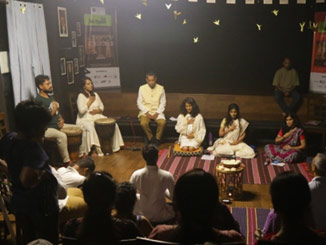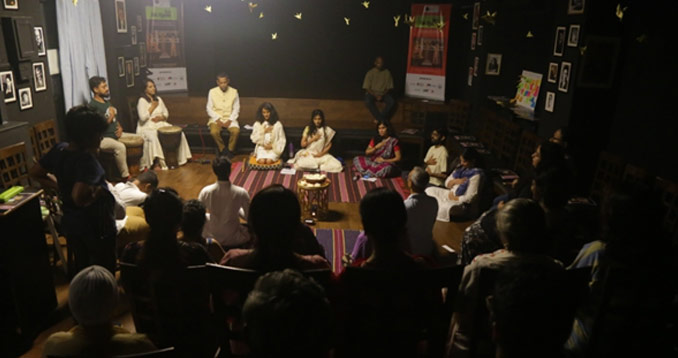

Sapan News Those at the opening ceremony of In Sync: India’s first forum for Interfaith Arts and Dialogue earlier this month saw a rather frazzled emcee, bumbling her way through the script. Witnesses included chief guest, the actor Sushant Singh and Father Magi Murzello, rector of St. Andrew’s College of Arts, Science and Commerce, besides 40-odd audience members.
Many would not have known in those awkward initial moments that the emcee was also the creator, curator, researcher, writer, designer, marketer, project coordinator, and producer of the event. They would not have known the absolute chaos of the last few weeks.
I had bitten off SO much that even five more sets of teeth and tongue would have fallen short at that moment. For almost four years, I had been laying the groundwork for what would become India’s (and possibly the world’s) first-ever forum for interfaith arts and dialogue. A lot was at stake. In Sync was coming to life, and like any first-time mother, I was a nervous wreck.
It was the fall of 2019. I had just started my professional doctorate programme in Interfaith Studies at the University of Wales Trinity Saint David, UK. A month in, I was feeling the bite of not just the Welsh winter but also homesickness. It was my first time out of India, and that too in a small university town with nearly no other brown faces. But the true extent of homesickness hit me when protests against the ruling government’s Citizenship Amendment Act (CAA), National Register of Citizens (NRC) and National Population Register (NPR) developed into a vivid fullness across India. From a distance, I watched a people’s movement take shape, unlike anything I had witnessed before. I alternately felt indignation at the state, and admiration for her people for upholding some of the most sacred values of democracy.
As an interfaith research scholar, I was more struck by the solidarities that were blossoming on the streets of Shaheen Bagh and a thousand other galis and nukkads (bylanes and crossroads) across India.
I had never seen such a public show of support from Hindus and other faith communities towards Muslim citizens, who are otherwise recipients of prejudice and hatred, and indeed the most vulnerable in the face of the discriminatory CAA, NRC and NPR.
My heart swelled as I saw people sing Hum dekhenge (the Faiz Ahmed Faiz composition that acquired an anthem-like significance during the anti-CAA-NRC protests), draw heartwarming graffiti, and even hold interfaith prayer services at the protest sites. It was electrifying to witness such unity and to know that India’s citizens were still capable of such compassion despite the best divisive efforts of majoritarian forces.
I wanted so badly to be in my homeland, to be a part of the history being created in those months. To my emotionally-charged head, the stoic Western paradigms of theology-based interfaith engagement seemed dull, because back home, faith communities were engaging in ways that were so, so different.
I returned home soon enough, forced to stay on by the Covid-19 pandemic. It affected not just the anti-CAA-NRC-NPR protests but life as we knew it. While working on my doctoral thesis, I tried to invent a model of interfaith engagement that would speak to not just the people of India, but all of Southasia.
By 2023, life had resumed a certain normalcy and the ruling dispensation was back to deploying its propagandist media and fake-news machinery to stir up communal rift at any given opportunity. As a journalist, I had written for years about what was wrong. This time, I was determined to do something about it.
The prevalent majoritarian politics necessitated the need to work towards interfaith harmony. I drew strength from the memory of the anti-CAA-NRC protest movement, when the power of the people coursed through the streets of India.
The recent public response to the Bharat Jodo Yatra (‘march to unite India’), helmed by opposition politician Rahul Gandhi, confirmed my belief that most Indians knew and wanted peace between communities. Perhaps they only needed a little help with how to achieve it.
My parallel career in peacework gave me the framework and the tools, and I decided to lean into our legacy of syncretic culture. Syncretism is the amalgamation or attempted amalgamation of different religions, cultures, or schools of thought. My doctoral work was essentially to formulate a theoretical model using syncretic art as the catalyst, the starting point of interfaith dialogue.
Since India’s biggest religious community, the Hindus, have little theological common ground with her other biggest minorities, Muslims and Christians, I deduced that standard (read: Western) theology-oriented interfaith dialogue models with faith leaders at the helm would not work.
It was the citizens most affected by continual communal conflict who needed to lead and participate in such dialogue. After all, faith is not the sole preserve of faith leaders. For a deeply religious subcontinental population, faith is an important aspect of our identities.
We needed to find places and opportunities to come together not just to celebrate commonalities, but also work through our differences. And what better way to do this than to partake in centuries of collective culture and art? I would remind people of what they already knew, build upon our pluralities, and marry it with peacebuilding.
Poets for PeaceDialogue session by Rukmini Iyer
The idea of In Sync emerged while wanting to move from theory to praxis. I envisioned a forum at the centre of which would be a pop-up exhibition of knowledge panels on some of India’s syncretic art forms. These art forms – with clear resonances of Hindu, Muslim, and other cultures – would become the basis of mutual appreciation and an entry point into deeper dialogue about communal matters that plague us.
Dialogue would be the peacebuilding tool of choice, with a trained facilitator leading the sessions between participants of different faith communities. This model would be replicable and applicable to different contexts, and easy to set up. In Sync was created as an experimental container, a physical (or virtual!) space where people could contend with the sociocultural ailment of communal tension festering for centuries.
For almost two years, I walked around with the concept note, pitching to likely individuals and organisations. With no precedents, it was hard to explain, and rejections flew thick and fast. But I continued to work in the interfaith space, learning, building capacity and credibility, pitching whenever I spotted a likely partner.
The first breakthrough happened less than a couple of months ago when my university gave me a microgrant towards completing what was essentially a part of my doctoral work. That is all I needed to make that leap of faith. I jumped in with the kind of resolve that appears foolhardy in retrospect. But I was quickly able to garner more partnerships and sponsorships, like pieces of a magical puzzle falling into place.
As supporters and the production funds came together, the vision grew. For its inaugural edition, I was able to offer real-life performances of some of those syncretic arts that my knowledge panels spoke about.
Day one comprised a kathak performance by Sanjukta Wagh that spelt out the many instances of syncretism embodied in the classical dance form. It was unusual but not shocking to see a Shiva Stotram and a Begum Akhtar song in the span of one performance. This was followed by the first of three interfaith dialogue sessions. The first and last ones were led by leadership coach and trained dialogue facilitator, Rukmini Iyer.
Day two comprised a talk titled ‘Mary in a Saree’ on the Indo-Christian art of Angelo da Fonseca by Dr Omkar Bhatkar, co-founder and director of the St. Andrew’s Centre for Philosophy and Performing Arts, the event’s venue partner.
Mythologist and author Utkarsh Patel made a presentation titled ‘Many Myths, One People’, on syncretic myths and folk narratives. His talk included the legends of Bon Bibi and Dakkhin Rai, the striking Islamic influences on Mapilla Ramayana, and the tale of Bibi Nacharamma, the Muslim consort of Lord Venkateshwara.
There was also a session introducing interfaith harmony for teenagers, led by facilitator Rhea Dsouza, and some ‘Poets for Peace’ who presented poetry and music from the past and present that showcase India’s syncretic spirit. Poets Kiran Bhat, Tripurari, and Geet Sagar ‘Awaazz’ recited their original works in Hindi, English, Kannada and Maithili, while singer Sukanya Purkayastha presented a poem by Bulleh Shah, followed by the hit Bollywood song Yeh taara woh taara.
On day three, music facilitators Mayuree Pandit and Leslie Nazareth, accompanied by educator Romana Shaikh led the ‘Chants for Harmony’ session, where participants engaged in multi-faith chanting as a group. Then followed a performance titled ‘Whirling Mandala’ by dancer and sacred arts practitioner, Zia Nath, inspired by the Sufis and the ghoomar tradition of Rajasthan.
Kathak performance by Sanjukta Wagh and the Beej dance troupeWhirling Mandala performance by Zia Nath
All three evenings saw a full house with many visitors leaving encouraging feedback about the diversity of performances and thought-provoking ideas. The dialogue sessions, which were meant to be the central offering of the forum, received less attention.
Creating any paradigm shift takes effort and consistency. I don’t know how long I will be able to persevere on this path given the political climate, or whether this event will yield any enduring results. What I know for sure is the value of love as the guiding principle of any endeavour. What is offered with love is received with love.
This upholds what Sant Kabir said centuries ago:
Pothi padh padh jag muaa, pandit bhayaa na koye,
Dhai aakhar prem kaa, Padhe so pandit hoye ||
(Reading scripture or books does not a scholar make
A truly learned one is he, who some words of love spake.)
Urmi Chanda is an interfaith researcher, culture writer, and peacebuilder based in Mumbai, India.

Leave a Reply